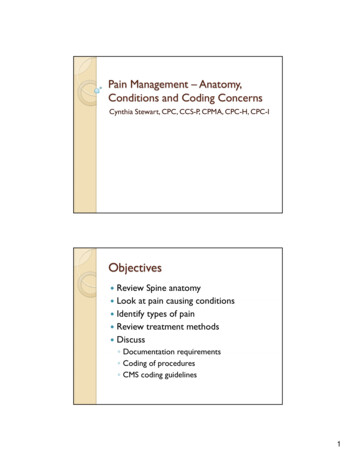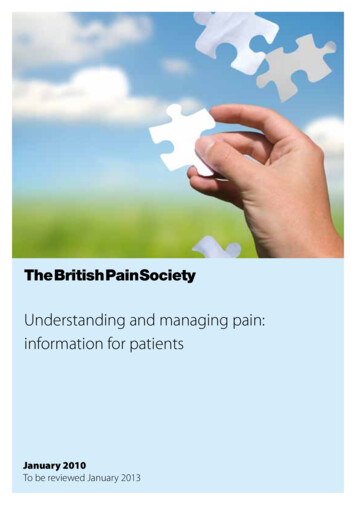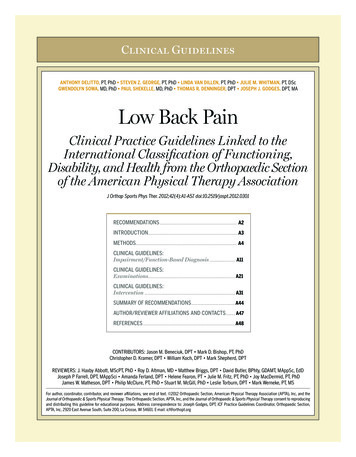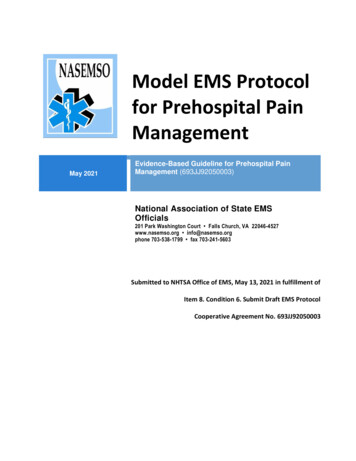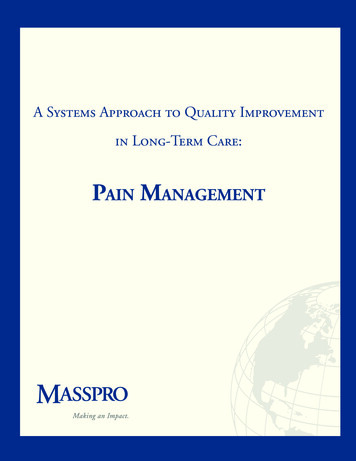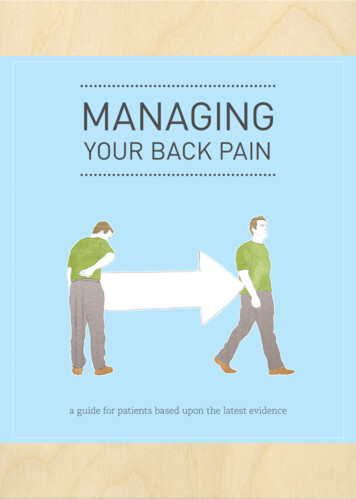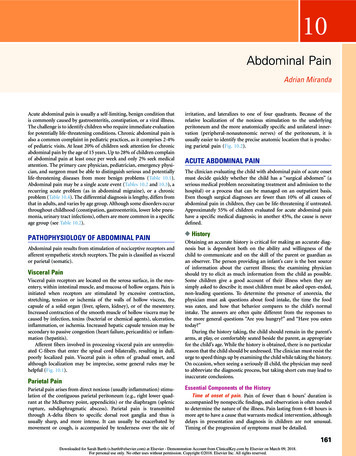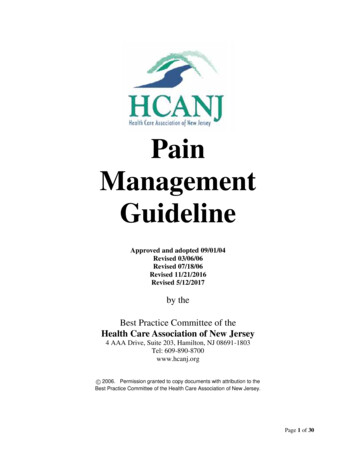
Transcription
PainManagementGuidelineApproved and adopted 09/01/04Revised 03/06/06Revised 07/18/06Revised 11/21/2016Revised 5/12/2017by theBest Practice Committee of theHealth Care Association of New Jersey4 AAA Drive, Suite 203, Hamilton, NJ 08691-1803Tel: 609-890-8700www.hcanj.org 2006. Permission granted to copy documents with attribution to theBest Practice Committee of the Health Care Association of New Jersey.Page 1 of 30
HCANJ Best Practice Committee’sPain Management GuidelineTable of ContentsPageDisclaimer .3Pain Management Guidelines Mission Statement .4 Definitions .4 Objectives .4 Program OutlineI.Pain Screen .5II.Pain Rating Scale .5III. Pain Assessment .5IV. Tools .5V.Pain Management Plan Development andImplementation 6 - 12VI. Education and Training 12VII. Continuous Quality Improvement .12 - 13VIII. Policy .13Pain Management Tools .14 - 26 Pain Screen Forms Pain Rating Scale Form Pain Assessment Forms Pain Management: Rating/Medication Administration Record Pain Management: Rating/Treatment Administration Record Data Collection For Analysis, Outcome Evaluation and PerformanceImprovement Forms — Pain Screen Form Pain Assessment Form Pain Treatment FormBibliography / Reference Citing .27 - 30Page 2 of 30
HCANJ Best Practice Committee’sPain ManagementBest Practice GuidelineDisclaimer: This Best Practice Guideline is presented as a model only by way of illustration. It has not beenreviewed by counsel. Before applying a particular form to a specific use by your organization, it should bereviewed by counsel knowledgeable concerning applicable federal and state health care laws and rules andregulations. This Best Practice Guideline should not be used or relied upon in any way without consultationwith and supervision by qualified physicians and other healthcare professionals who have full knowledge ofeach particular resident’s case history and medical condition.This Best Practice Guidelines is offered to nursing facilities, assisted living facilities, residential health carefacilities, adult day health services providers and other professionals for informational and educationalpurposes only.The Health Care Association of New Jersey (HCANJ), its executers, administrators, successors, andmembers hereby disclaim any and all liability for damage of whatever kind resulting from the use, negligentor otherwise, of all Best Practice Guidelines herein.This Best Practice Guideline was developed by the HCANJ Best Practice Committee (“Committee”), agroup of volunteer professionals actively working in or on behalf of health care facilities in New Jersey,including skilled nursing facilities, sub-acute care and assisted living providers.The Committee’s development process included a review of government regulations, literature review,expert opinions, and consensus. The Committee strives to develop guidelines that are consistent with theseprinciples: Relative simplicity Ease of implementation Evidence-based criteria Inclusion of suggested, appropriate forms Application to various long term care settings Consistent with statutory and regulatory requirements Utilization of MDS (RAI) terminology, definitions and data collectionAppropriate staff (Management, Medical Director, Physicians, Nurse-Managers, Pharmacists, PharmacyConsultants, Interdisciplinary Care Team) at each facility/program should develop specific policies,procedures and protocols to best assure the efficient, implementation of the Best Practice Guideline’sprinciples.The Best Practice Guidelines usually assume that recovery/rehabilitation is the treatment or care plan goal.Sometimes, other goals may be appropriate. For example, for patients/residents receiving palliative care,promotion of comfort (pain control) and dignity may take precedence over other guideline objectives.Guidelines may need modification to best address each facility, patient/resident and family’s expectationsand preferences.Recognizing the importance of implementation of appropriate guidelines, the Committee plans to offereducation and training. The HCANJ Best Practice Guidelines will be made available at www.hcanj.org. 2006. Permission granted to copy documents with attribution to theBest Practice Committee of the Health Care Association of New Jersey.Page 3 of 30
MISSION STATEMENTThe mission of a Pain Management Program is to promote the health, safety and welfare of residents innursing facilities, assisted living, residential health care facilities and adult day health services, byestablishing guidelines to meet the state’s requirements for the assessment, monitoring and management ofpain.DEFINITIONS Pain means an unpleasant sensory and emotional experience associated with actual or potential tissuedamage or described in terms of such damage.A. Pain Classification Somatic Pain: Result of activation of nociceptors (sensory receptors) sensitive tonoxious stimuli in cutaneous or deep tissues. Experienced locally and described asconstant, aching and gnawing. The most common type in cancer patients. Visceral Pain: Mediated by nociceptors. Described as deep, aching and colicky. Ispoorly localized and often is referred to cutaneous sites, which may be tender. Incancer patients, results from stretching of viscera by tumor growth.B. Chronic Pain Classification Nociceptive pain: Visceral or somatic. Usually derived from stimulation of painreceptors. May arise from tissue inflammation, mechanical deformation, ongoinginjury, or destruction. Responds well to common analgesic medications and non-drugstrategies. Neuropathic Pain: Involves the peripheral or central nervous system. Does notrespond as predictably as nociceptive pain to conventional analgesics. May respond toadjuvant analgesic drugs. Mixed or undetermined pathophysiology: Mixed or unknown mechanisms.Treatment is unpredictable; try various approaches. Psychologically based pain syndromes: Traditional analgesia is not indicated. Pain Management means the assessment of pain and, if appropriate, treatment in order to assure theneeds of residents of health care facilities who experience problems with pain are met. Treatment ofpain may include the use of medications or application of other modalities and medical devices, suchas, but not limited to, heat or cold, massages, transcutaneous electrical nerve stimulation (TENS),acupuncture, and neurolytic techniques such as radiofrequency coagulation and cryotherapy.Pain Rating Scale means a tool that is age cognitive and culturally specific to the patient/residentpopulation to which it is applied and which results in an assessment and measurement of the intensity ofpain.Pain Treatment plan means a plan, based on information gathered during a patient/resident painassessment, that identifies the patient’s/resident’s needs and specifies appropriate interventions toalleviate pain to the extent feasible and medically appropriate. OBJECTIVES To reduce the incidence and severity of pain and, in some cases, help minimize further healthproblems and enhance quality of life.To provide professional staff with standards of practice that will assist them in the effective assessment,monitoring and management of the resident’s pain.To educate the resident, family and staff.Page 4 of 30
To limit liability to health care providers.PROGRAM OUTLINEI.PAIN SCREENA. A Pain Screen, including a Pain Rating Scale, shall be conducted upon admission.II. PAIN RATING SCALEA. One of the 4 following Pain Rating Scales (or other evidence based rating scales as they becomeavailable) shall be used as appropriate for the individualresident:1. Wong-Baker Scale2. Numerical Scale3. FLACC Scale4. PAINADB. A Pain Rating Scale shall be completed and documented, at a minimum, in the followingcircumstances:1. as part of the Pain Screening upon admission2. upon re-admission3. upon day of planned discharge (send a copy with the resident)4. when warranted by changes in the resident’s condition or treatment plan5. self reported pain and/or evidence of behavioral cues indicative of thepresence of pain is requires a “short assessment” every shift in a skilled nursing facility6. to identify and monitor the level of pain and/or the effectiveness of treatmentmodalities until the patient/resident achieves consistent pain relief or pain control asidentifiedC. If the patient/resident is cognitively impaired or non-verbal, the facility shall utilize pain ratingscales for the cognitively impaired and non-verbal resident. (see suggested tools in Appendix)Additionally, the facility shall ask for information from the resident’s family, caregiver or otherrepresentative, if available and known to the facility.III.PAIN ASSESSMENTA. A complete Pain Assessment shall be done if the Pain Rating Scale score is above 0 in thecircumstances listed in II-B, no. 1-5 indicated on The Wong Baker Faces or FLACC scales,a 1 or 2 as indicated by the PAINAD included with the Pain Management Tools.B. A Pain Assessment shall be conducted whenever a new onset of pain occursC. In skilled nursing facilities, a complete Pain Assessment shall be completed at admission, ifpain is identified, an assessment must be completed on every shift. ( MDS 3.0; Section J,)Complete the appropriate Pain Assessment at the time of the quarterly MDS if pain has beenrecorded. .D. In assisted living communities, the evaluations/assessments are completed at a frequencyrequired by state regulations and shall include a pain rating scale appropriate to the resident. Ifgreater than 0 on the Wong Baker, or a FLACC of 1 or greater or a 1 or 2 on the PAINAD aPain Assessment shall be completed. In addition, it is recommended that a pain screen becompleted during the monthly wellness check followed by an assessment if pain is indicated.E. In residential health care and adult day health services, a Pain Assessment shall becompleted upon admission, when pain is reported or suspected, and every sixmonths and annually thereafter.IV. TOOLSA. Pain ScreenPage 5 of 30
B. Pain Rating ScaleC. Pain AssessmentV. PAIN MANAGEMENT PLAN DEVELOPMENT AND IMPLEMENTATIONNon- Pharmaceutical InterventionsA. Information collected from the Pain Assessment is to be used to formulate andimplement an individualized person centered Pain Management plan of care based onthe resident's ability to function comfortably. If it is not possible to achieve the optimalPain Management plan for the patient/resident, the patient/resident shall bereferred for Pain Management to an expert pain consultant.B. Rehabilitation Treatment Modalities (Physical Therapy-PT /Occupational Therapy-OT):1. PT Intervention: Therapeutic Exercise Passive range of motion, active assistive range of motion, active range ofmotion, progressive resistive exercise, balance training, gait training, posturalcorrection and reeducation, ergonomics.2. PT Intervention: Manual Therapy Mobilization and manipulation of the joints, craniosacral therapy, myofascialrelease, massage.3. PT Intervention: Modalities Electrical stimulation, transcutaneous electrical nerve stimulation,iontophoresis, ultrasound, diathermy, infrared, hydrotherapy (warm), fluidtherapy, cold laser, hot packs, paraffin wax therapy, ice packs.4. OT Intervention for Pain Reduction: Activity of daily living, adaptive devices to simplify tasks, energyconservation techniques, therapeutic exercises, wheelchair measurement,wheelchair positioning devices, bed positioning devices, cushions forappropriate pressure relief, splinting for stretching tight joints/muscles, reducepain and prevent pressure sore.5. Both PT and OT upon discharge from the therapy program should provide: Illustrated home exercise program, in-service to the caregiver.6. Guided Internet-Based Psycho-Education Intervention Using Cognitive BehavioralTherapy:1. Assess the resident, especially those with cognitive impairment, for unmetneeds which could be interpreted as pain such as hunger, lonliness, depression,need to be toileted, to speak to a loved one, sleeplessness, anxiety and meetthe need.2. Assure the patient/resident is comfortable; reposition, if appropriate topatient’s/resident's level of function engage in an activity such aswalking.For patients/residents who suffer from Chronic Pain there is a new systemof non-pharmacological interventions know as, “Guided Internet-BasedPsycho-Education Intervention Using Cognitive Behavioral Therapy (CBT)and Self-Management (SM) for Individuals With Chronic Pain.”This study was conducted to determine strategies for improved access to evidence basednon-pharmacological interventions for the management of chronic pain. The premise is toPage 6 of 30
provide, online education, guidance and interventions which are non-pharmacologic innature for persons trying to manage chronic pain with little or no access to formalpsychological services. The following information was extracted from the entire project asan informational resource for nurses and the patients/residents for whom they provide care:“The most effective treatments for chronic pain involve an interdisciplinary approach(Jeffery, Butler, Stark, & Kane, 2011; Scascighini, Toma, Dober-Spielmann, & Sprott,2008; Turk, Wilson, & Cahana, 2011). Pharmacologic treatment is most commonlyutilized, but other treatments are less consistently accessed. In particular, psychologicalinterventions for chronic pain management are not readily available at a primary care leveldue to funding, time constraints, and lack of adequately trained staff (Jeffery et al., 2011).”“Study Conclusion: In examining the status of accessibility to chronic pain care, aneed was identified: individuals should have an opportunity to continue to moveforward in treatment even if they do not have access to in-person,psycho-education, CBT, and SM therapies. Internet delivery of evidence-basedtherapies may benefit individuals with chronic pain. Considering factors such asdemographics, environment, supports and symptoms, and building on previousresearch, an intervention was constructed for delivery via the Internet. Pilot testingof the intervention, with a view to usability and exploratory outcomes, wascompleted to inform content revision and structure of larger-scale research Suggested Evidence-based Intervention Components Cognitive Behavioral Therapy (CBT)Self-Management (SM)EducationD. Pharmacological Intervention:As a result of a nationwide effort to reduce unnecessary Opioid use and reduceincidents of patient abuse, clinicians are encouraged to carefully assess theirpatient's/resident’s pain through assessment, limit the number of prescribednarcotic analgesics and limit further prescribing by evaluating the patient's/resident’spain relief and increased functional ability.The trend to lower usage has had a tremendous impact on opiod use as indicated in theannual reports from QuintilesIMS. By 2016, acetaminophen/hydrocodone, which hadbeen the leading medication prescribed for pain, had dropped from first most prescribedpain medication to the fourth most prescribed drug in the nation, with the volume ofprescriptions down 7.2% from 2015 and 34% from 2012.In order to facilitate this continuing trend it is recommended that the following WHOdecision ladder and in depth patient/resident assessment be utilized before requesting orprescribing opioid compounds.World Health Organization (WHO) LadderThe WHO Ladder was first published over twenty years ago (1986) in ahandbook called Cancer Pain Relief. Since then, the Ladder has guidedclinicians all over the world in treating cancer as well as non-cancer pain.Figure 1. The WHO Ladder (adapted).Page 7 of 30
The WHO Ladder is part of an overall pain treatment method that centers on fivekey principles: "By Mouth": use the oral route whenever possible, even for opioids “By the Clock”: For persistent pain, provide medication at regular intervals(around the clock) rather than PRN (as needed) "By the Ladder": (Figure 1) Step 1: For mild to moderate pain, start with a nonopioid (e.g.,acetaminophen, ibuprofen) and increase the dose, if necessary tothe maximum recommended dose. Use an adjuvant such as an anti-depressant or anticonvulsant, ifindicated If the patient presents with moderate or severe pain skip Step 1. Step 2: If or when non-opioids do not adequately relieve pain, add anopioid intended for moderate pain such as hydrocodone (combinedwith acetaminophen). Add or continue adjuvants, if appropriate Step 3: If or when the non-opioid for mild to moderate pain no longeradequately relieves the pain, switch to an opioid that is notcombined with another agent such as acetaminophen, and one thatis effective for moderate to severe pain (e.g. morphine, oxycodone,hydromorphone). Add or continue adjuvants, if appropriate "For the Individual":individualize the Pain Management Program according to thepatient’s goals to incorporate Person Centered criteria to meet thepatient’s pain needs.Page 8 of 30
1. Non-opioid analgesics, such as acetaminophen, aspirin, and nonsteroidalanti-inflammatory drugs (NSAIDs), cyclooxygenase-2 (cox-2) inhibitors andtramadol. Considered but not recommended: Indomethacin, Prioxicam, Tolmetin,Meclofenamate.2. Opioid analgesics include but not limited to: (oxycodone; morphine, transdermalfentanyl; hydromorphone; methadone; combination opioid preparations, such ascodeine, hydrocodone, Oxycodone. Considered but not recommended: Propoxyphene,Meperidine, Pentazocine, Butorphanol Before starting opioid therapy for chronic pain, it is recommended, based onperson-centered care, a clinician work to establish pain management goals thatutilize non-pharmacological methods that will increase the patient/resident’sdaily functional abilities at a comfortable level. What is a comfortable level?The level of pain that is tolerated by the established to enable a degree ofindependence in activities of daily living. With continuing assessment,evaluation and as the increase independence there is a continued reduction inthe necessity for narcotic analgesics. Clinicians should establish treatment goals with all patients/residents andunderstand at what level on the selected Pain Scale the patient/resident feelsthey are comfortable and able to function. Every person’s tolerance to pain issubjective. If a patient says they have pain, they do have pain. If they say theyhave pain at an 8 they do. A five on the pain scale may be uncomfortable forsome else. At what level is the pain manageable for THIS resident. Once that isestablished, person centered goals can be set including realistic goals for painand function, and should consider how opioid therapy will be discontinued ifbenefits do not outweigh risks. Clinicians should continue opioid therapy onlyif there is clinically meaningful improvement in pain and function thatoutweighs risks to patient/resident safety . When possible, abuse-deterent opioids should be utilized to minimize the riskand provide an additional barrier to opioid abuse Patients/Residents Aged 65 years- Inadequate pain management amongpersons aged 65 years has been documented (204). Pain management forolder patients/residents can be challenging given increased risks of bothnon-opioid pharmacologic therapies (see Recommendation 1) and opioidtherapy in this population. Per Dr. Manan Patel (April 25,2017) there are:Page 9 of 30
Age related changes effecting Pain Management: Decrease in pain receptors at the skin Impaired Conduction velocities Loss of neurons at dorsal horns. Decrease in EEG amplitude and increase in latency to painfulstimuli have been reported Changes in painful thermal stimuli implies frontal and lateralwider recruitment of neurons and slower cognitive medications Ethical/cultural/religious beliefs placing admission of pain as asign of weakness Family and staff concerns about accidental overdosesComplications of dementia :The intensity of painful conditions and the administrationof analgesic medication seem to be inversely related asdementia progresses Patients/Residents may have difficulty expressing the pain orinability due to neuropathologic changes which often resultin misinterpreted signals processing Barriers to effective Pain Management: Many elders can be more reluctant than young people to reportpainful stimuli Physician, family and staff concerns about addiction to pain As dementia worsens patients/residents may show more facialexpressiveness. This may or may not be related to pain and shouldbe investigated before seeking a pharmaceutical solution. Staffand families must rely on patient/resident facial expressions (asillustrated in the Advanced Dementia Pain Scale in theappendix)and body language as pain indicators for the non-verbalperson. Abrupt changes in behavior and function might be the bestindicators of pain.3. Reduced renal function and medication clearance even in the absence of renal disease,in patients/residents aged 65 years might have increased susceptibility toaccumulation of opioids and a smaller therapeutic window between safe dosages anddosages associated with respiratory depression and overdose (contextual evidencereview). Some older adults suffer from cognitive impairment, which can increase riskfor medication errors and make opioid-related confusion more dangerous. In addition,older adults are more likely than younger adults to experience co-morbid medicalconditions and more likely to receive multiple medications, some of which mightinteract with opioids (such as benzodiazepines). Clinicians should use additionalcaution and increased monitoring to minimize risks of opioids prescribed forpatients/residents aged 65 years. Experts suggested that clinicians educate olderadults receiving opioids to avoid risky medication-related behaviors such as obtainingcontrolled medications from multiple prescribers and saving unused medications. Forresidents' transitioning back into the community whose pain level requires thecontinued use of an opioid, clinicians need to provide education related to medicationmanagement, side effects, risk of falls, and all other risks associated with Opiod use.Clinicians should educate representatives/care givers for those with memoryimpairment and cognitive decline on safe administration, side effects and riskPage 10 of 30
associated with controlled medications. Clinicians should also implementinterventions to mitigate common risks of opioid therapy among older adults, such asexercise or bowel regimens to prevent constipation, risk assessment for falls, andpatient/resident monitoring for cognitive impairment3. Other classes of drugs (corticosteroids, anticonvulsants, clonazepam, carbamazepine,anti-arrhythmics, topical local anesthetics, topical counter-irritants)4. Monitor for safety and side effects of medications. Utilize The Four A's of pain treatment outcomes (Passik and Weinreb, 1998)which are:Analgesia (pain control),Activities of daily living (patient/resident functioning and quality of life),Adverse events (medication side effects) andAberrant drug-related behavior (addiction related outcomes).5. Principles of Pharmacological treatment of chronic pain: Administer medication routinely, not PRN (as needed). PRN analgesic may beadministered for breakthrough pain or when resident/staff identifiescircumstances when pain may be anticipated, On-going communication isrecommended with the healthcare provider for optimal pain management.prior to wound treatment or skilled therapy.Use the least invasive route of administration first. The oral route ispreferred.Using the WHO Pain Ladder begin with a low dose. Titrate carefully untilcomfort is achieved.Reassess and adjust does frequently to optimize pain relief while monitoringand managing side effects.Maximize therapeutic effect while minimizing medication side effects.6. General Pain Management Principles: A sk about pain regularly B elieve the patient’s/resident’s & family’s reports of pain and what relieves itC hoose appropriate pain control optionsD eliver interventions in a timely, logical and coordinated fashionE mpower patients/residents and their familiesD. Alternative Interventions:1. Acupuncture, reflexology, aroma therapy, music therapy, dance therapy, yoga,hypnosis, relaxation and imagery, distraction and reframing, psychotherapy, peersupport group, spiritual, chiropractic, magnet therapy, bio-feedback, meditation,relaxation techniques, Cognitive Behavior Therapy, Self-Management, education.E. Pain Assessment findings shall be documented in the resident’s medical record. This shallinclude, but not be limited to, the date, pain rating, pain rating tool, treatment plan, andpatient/resident response.F. In order to meet or exceed state and or federal quality initiatives and requirements ( (QualityAssurance (QA) and Performance Improvement (PI)) and maintain control over painmanagement medications and patient/resident outcomes it is further suggested that a PainPage 11 of 30
Management monthly summary be created and logged as part of your facility quality program.The summary should review the medications administered, the numbers of opioids ordered andadministered (Information readily available from your pharmacy provider) and theeffectiveness of the overall month’s administration. This allows for better medical and nursingmanagement of that particular resident's ability to function and at what level they are able tofunction comfortably. Also, at this assessment of pain management meeting whatnon-pharmacological interventions have been of benefit or what may be reviewed further withthe patient/resident, representative if applicable, the care giver staff and the healthcareprovider. PRN medications (as needed) utilization is also reviewed. An increase in PRNnarcotic analgesic is an indicator the patient/resident's pain is not effectively being managedand the Pain Management plan should be revisited and revised. It should also be determinedwhether to discontinue ANY medication especially if not administered in 30 days. The datacollected from these monthly meetings may be utilized as part of the Nursing Department’squality assurance program.VI. EDUCATION AND TRAININGA. The policy for each facility shall include the criteria found in subchapter 6, GeneralLicensure Procedures and Enforcement of Licensure Rules, NJAC 8:43E 6.5 (a) 1-4 , (b):“(a) Each facility shall develop, revise as necessary and implement a written plan forthe purpose of training and educating staff on pain management. The plan shallinclude mandatory educational programs that address at least the following:(b)1. Orientation of new staff to the facility’s policies and procedures on painassessment and management;2. Training of staff in pain assessment tools; behaviors potentially indicatingpain; personal, cultural, spiritual, and/or ethnic beliefs that may impact apatient’s/resident’s perception of pain; age related changes in perception topain, new equipment and new technologies to assess and monitor apatient’s/resident’s pain status;3. Incorporation of pain assessment, monitoring and management,non-pharmaceutical and pharmaceutical, into the initial orientation andongoing education of all appropriate staff; and4. rights.Implementation of the plan shall include records of attendance for each program.”B. /Family Education: Explain causes of the pain, assessment methods, treatment options and goals, use ofanalgesics and non- pharmaceutical self-help techniques. Regularly reinforce educational content. Provide specific education before special treatments and/or procedures.VII. CONTINUOUS QUALITY IMPROVEMENTThe policy for each facility shall include the criteria found in subchapter 6, General LicensureProcedures and Enforcement of Licensure Rules, NJAC 8:43E 6.6:“The facility’s continuous quality improvement program shall include a systematicreview and evaluation of pain assessment, management and documentation practices.The facility shall develop a plan by which to collect and analyze data in order toevaluate outcomes or performance. Data analysis shall focus on recommendations forimplementing corrective actions and improving performance.”VIII. POLICYA. Each facility shall develop a policy to define the system for assessing and monitoringpatient/resident pain.B. The policy for each facility shall include the criteria found in subchapter 6, GeneralPage 12 of 30
Licensure Procedures and Enforcement of Licensure Rules, NJAC 8:43E 6.4(f) 1-7:“(f) The facility shall establish written policies and procedures governing themanagement of pain that are reviewed at least every year and revised morefrequently as needed. They shall include at least the following:1. A written procedure for systematically conducting periodic assessment of apatient’s/resident’s pain, as specified in (b) *above. At a minimum theprocedure must specify pain assessment upon admission, upon discharge,and when warranted by changes in a patient’s/resident’s condition and selfreporting of pain;2. Written criteria for the assessment of pain, including, but not limited to: painintensity or severity, pain character, pain frequency or pattern, or both; painlocation, pain duration, precipitating factors, responses to treatment and thepersonal, cultural, spiritual, and/or ethnic beliefs that may impact anindividual’s perception of pain;3. A written procedure for the monitoring of a patient’s/resident’s pain;4. A written procedure to insure the consistency of pain rating scales acrossdepartments within the health care facility;5. Requirements for documentation of a patient’s/resident’s pain status in themedical record;6. A procedure for educating patients/residents and, if applicable, their familiesabout pain management when identified as part of their treatment; and7. A written procedure for systematically coordinating and updating
Pain Management Guideline Approved and adopted 09/01/04 Revised 03/06/06 Revised 07/18/06 Revised 11/21/2016 Revised 5/12/2017 by the Best Practice Committee of the Health Care Association of New Jersey 4 AAA Drive, Suite 203, Hamilton, NJ 08691-1803 Tel: 609-890-8700




